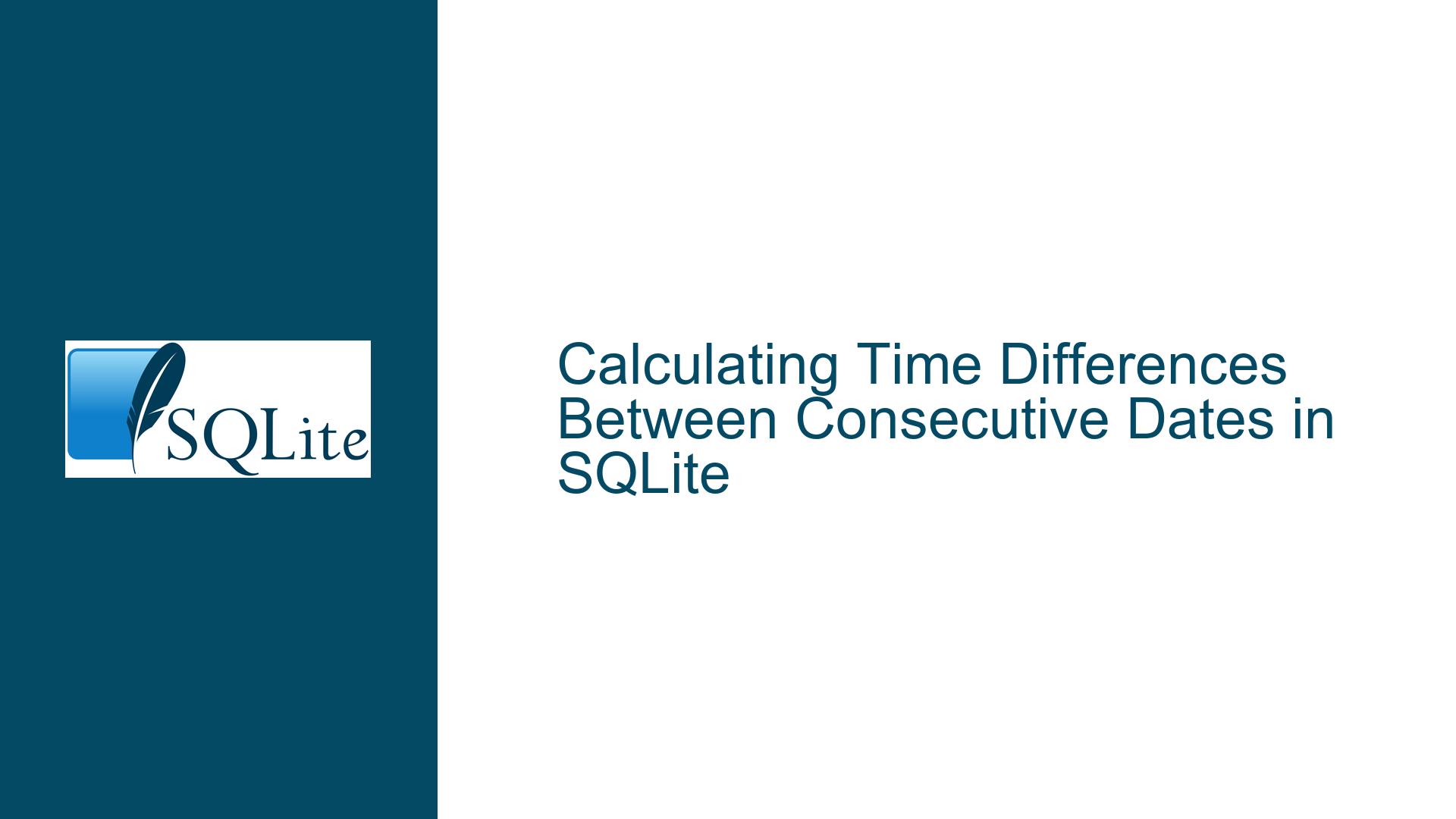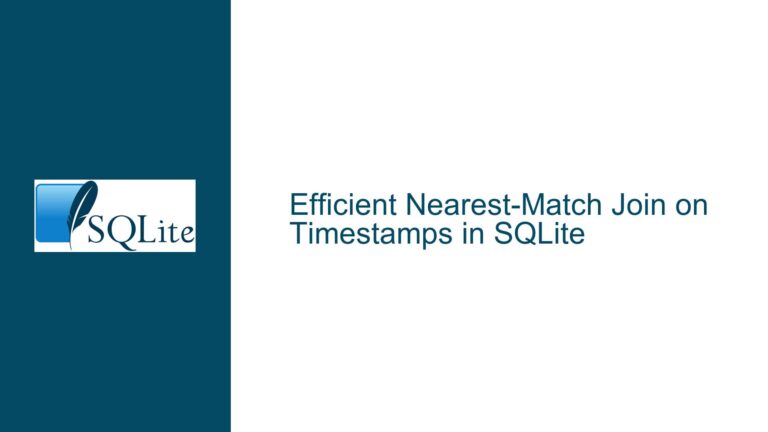Calculating Time Differences Between Consecutive Dates in SQLite
Issue Overview: Calculating Intervals Between Ordered Dates
The core challenge presented revolves around determining the time intervals between consecutive events—specifically, concerts in this scenario—stored in an SQLite database. The primary objective is to compute the duration between the two most recent events and, more generally, between each event and its immediate predecessor when ordered chronologically. This requires leveraging SQLite’s date and time functions alongside window functions to access preceding rows’ data.
The concerts table structure includes an id, artist, and concertDate column, with dates stored as TEXT in the ‘YYYY-MM-DD’ format. The initial dataset includes four entries spanning from 1998 to 2019. The goal is to derive a SQL query that calculates the difference between the most recent concert (2019-03-22) and the second most recent (2007-03-22), resulting in a 12-year gap (or 4,383 days). Additionally, the solution should extend to computing intervals for all consecutive pairs of dates when sorted in ascending order.
Key complexities include ensuring accurate date arithmetic, handling edge cases (e.g., the earliest concert having no predecessor), and formatting results in meaningful units (days, months, years). The discussion highlights multiple approaches, including subqueries, correlated subqueries, and window functions, with an emphasis on the latter for their efficiency and scalability.
Possible Causes: Missteps in Date Handling and Row Sequencing
Several factors could impede accurate interval calculations:
Incorrect Date Formatting: SQLite’s date functions (
julianday(),strftime(), etc.) require dates to be in a recognized format (e.g., ‘YYYY-MM-DD’). IfconcertDatevalues deviate from this format or contain invalid dates, functions returnNULL, leading to erroneous calculations.Absence of Window Function Support: Queries relying on
LAG()orOVERclauses necessitate SQLite version 3.25.0 (2018-09-15) or later. Older versions lack window function support, rendering such queries invalid.Improper Ordering of Rows: Window functions and subqueries must explicitly order rows by
concertDateto ensure chronological sequencing. OmittingORDER BYclauses results in undefined row order, producing incorrect predecessor/successor relationships.Handling NULL Values: The first row in an ordered dataset has no predecessor, causing
LAG(concertDate, 1)to returnNULL. Failing to account for this yieldsNULLin difference calculations, which may require filtering or explicit handling.Units Conversion Ambiguity: Differences in Julian days must be converted to human-readable units (e.g., years, months). Naive division (e.g., 365 days/year) ignores leap years and month-length variability, introducing inaccuracies.
Subquery Performance Issues: Correlated subqueries to identify predecessors (e.g.,
SELECT MAX(concertDate) WHERE concertDate < current_date) may suffer from performance degradation on large datasets due to repeated full-table scans.
Troubleshooting Steps, Solutions & Fixes
1. Validating and Standardizing Date Formats
Step 1: Verify Date Integrity
Ensure all concertDate values adhere to valid formats. Use a query to detect anomalies:
SELECT concertDate
FROM concerts
WHERE concertDate NOT LIKE '____-__-__'
OR julianday(concertDate) IS NULL;
This returns rows where concertDate is malformed or unparsable. Correct invalid entries (e.g., ‘1998/04/18’ → ‘1998-04-18’).
Step 2: Convert Dates to Julian Days
SQLite’s julianday() function converts dates to fractional Julian days, enabling arithmetic operations. Compute this for all rows:
SELECT id, artist, concertDate, julianday(concertDate) AS jday
FROM concerts
ORDER BY concertDate;
Confirm that jday values are non-NULL and sequential.
2. Leveraging Window Functions for Consecutive Differences
Step 3: Use LAG() to Access Preceding Dates
The LAG(column, offset) window function retrieves values from preceding rows. Pair this with julianday() to compute intervals:
SELECT id, artist, concertDate,
LAG(concertDate, 1) OVER (ORDER BY concertDate) AS prev_date,
julianday(concertDate) - julianday(LAG(concertDate, 1) OVER (ORDER BY concertDate)) AS delta_days
FROM concerts
ORDER BY concertDate;
This yields:
┌─────┬──────────────┬─────────────┬─────────────┬───────────┐
│ id │ artist │ concertDate │ prev_date │ delta_days│
├─────┼──────────────┼─────────────┼─────────────┼───────────┤
│ 102 │ ELO │ 1998-04-18 │ NULL │ NULL │
│ 103 │ YES │ 2003-11-02 │ 1998-04-18 │ 2024.0 │
│ 101 │ JOE COCKER │ 2007-03-22 │ 2003-11-02 │ 1236.0 │
│ 100 │ FOO FIGHTERS │ 2019-03-22 │ 2007-03-22 │ 4383.0 │
└─────┴──────────────┴─────────────┴─────────────┴───────────┘
Step 4: Filter for Specific Intervals
To isolate the interval between the two most recent concerts:
WITH ranked_concerts AS (
SELECT id, artist, concertDate,
LAG(concertDate, 1) OVER (ORDER BY concertDate) AS prev_date,
julianday(concertDate) - julianday(LAG(concertDate, 1) OVER (ORDER BY concertDate)) AS delta_days
FROM concerts
)
SELECT prev_date AS second_latest, concertDate AS latest, delta_days
FROM ranked_concerts
WHERE concertDate = (SELECT MAX(concertDate) FROM concerts);
Result:
┌─────────────┬─────────────┬───────────┐
│ second_latest│ latest │ delta_days│
├─────────────┼─────────────┼───────────┤
│ 2007-03-22 │ 2019-03-22 │ 4383.0 │
└─────────────┴─────────────┴───────────┘
3. Handling SQLite Version Constraints
Step 5: Check SQLite Version
Window functions require SQLite ≥3.25.0. Verify compatibility:
SELECT sqlite_version();
For versions <3.25.0, use correlated subqueries:
SELECT c1.concertDate AS latest,
(SELECT MAX(c2.concertDate)
FROM concerts c2
WHERE c2.concertDate < c1.concertDate) AS prev_date,
julianday(c1.concertDate) - julianday(prev_date) AS delta_days
FROM concerts c1
WHERE c1.concertDate = (SELECT MAX(concertDate) FROM concerts);
4. Converting Julian Days to Other Units
Step 6: Derive Months and Years
Convert delta_days using average durations (1 year ≈ 365.25 days, 1 month ≈ 30.437 days):
SELECT id, artist, concertDate, prev_date, delta_days,
ROUND(delta_days / 30.437, 1) AS delta_months,
ROUND(delta_days / 365.25, 1) AS delta_years
FROM (
SELECT id, artist, concertDate,
LAG(concertDate, 1) OVER (ORDER BY concertDate) AS prev_date,
julianday(concertDate) - julianday(LAG(concertDate, 1) OVER (ORDER BY concertDate)) AS delta_days
FROM concerts
);
Output:
┌─────┬──────────────┬─────────────┬─────────────┬───────────┬──────────────┬─────────────┐
│ id │ artist │ concertDate │ prev_date │ delta_days│ delta_months │ delta_years │
├─────┼──────────────┼─────────────┼─────────────┼───────────┼──────────────┼─────────────┤
│ 102 │ ELO │ 1998-04-18 │ NULL │ NULL │ NULL │ NULL │
│ 103 │ YES │ 2003-11-02 │ 1998-04-18 │ 2024.0 │ 66.5 │ 5.5 │
│ 101 │ JOE COCKER │ 2007-03-22 │ 2003-11-02 │ 1236.0 │ 40.6 │ 3.4 │
│ 100 │ FOO FIGHTERS │ 2019-03-22 │ 2007-03-22 │ 4383.0 │ 144.0 │ 12.0 │
└─────┴──────────────┴─────────────┴─────────────┴───────────┴──────────────┴─────────────┘
5. Optimizing Subquery Performance
Step 7: Index concertDate for Faster Lookups
Create an index on concertDate to accelerate subqueries and window functions:
CREATE INDEX idx_concerts_date ON concerts(concertDate);
This optimizes MAX(concertDate) scans and WHERE concertDate < ... conditions.
Step 8: Materialize Intermediate Results
For large datasets, persist ranked results in a temporary table:
CREATE TEMP TABLE ranked_concerts AS
SELECT id, artist, concertDate,
LAG(concertDate, 1) OVER (ORDER BY concertDate) AS prev_date,
julianday(concertDate) - julianday(LAG(concertDate, 1) OVER (ORDER BY concertDate)) AS delta_days
FROM concerts;
Subsequent queries against ranked_concerts avoid recomputing window functions.
6. Addressing Edge Cases and Ambiguities
Step 9: Exclude NULL Intervals
Filter out the first row’s NULL delta using a WHERE clause:
SELECT *
FROM (
-- Window function query from Step 3
)
WHERE prev_date IS NOT NULL;
Step 10: Handle Zero-Day Gaps
If two concerts occur on the same date, the delta is zero. Account for this in application logic or via CASE statements:
SELECT id, artist, concertDate, prev_date,
CASE
WHEN delta_days = 0 THEN 'Same day'
ELSE CAST(delta_days AS TEXT)
END AS delta_days
FROM (
-- Window function query from Step 3
);
7. Alternative Approaches Using Unix Epoch Time
Step 11: Utilize Unix Timestamps
For precision to seconds, use strftime('%s', concertDate):
SELECT id, artist, concertDate,
LAG(concertDate, 1) OVER (ORDER BY concertDate) AS prev_date,
(strftime('%s', concertDate) - strftime('%s', LAG(concertDate, 1) OVER (ORDER BY concertDate))) / 86400.0 AS delta_days
FROM concerts;
Note: This assumes concertDate includes time components (e.g., ‘2019-03-22 20:00:00’).
8. Comprehensive Validation
Step 12: Add Test Cases
Insert known intervals to verify calculations:
INSERT INTO concerts VALUES (104, 'TEST ARTIST', '2022-01-01');
INSERT INTO concerts VALUES (105, 'TEST ARTIST', '2022-01-02');
Re-run queries to confirm a 1-day delta between IDs 104 and 105.
Step 13: Cross-Validate with External Tools
Export results to a CSV and validate intervals using external tools (e.g., Python’s pandas or spreadsheet software).
Final Solution Synthesis
The optimal approach combines window functions (LAG()) with julianday() for day-based intervals, ensuring:
- Correct Ordering:
OVER (ORDER BY concertDate)guarantees chronological processing. - Efficiency: Window functions compute intervals in a single pass, outperforming subqueries.
- Accuracy: Julian day arithmetic avoids month/year ambiguities.
For SQLite <3.25.0, use correlated subqueries with MAX(concertDate) and indexing to mitigate performance issues. Always validate date formats and handle edge cases (e.g., NULL deltas) to ensure robustness.






